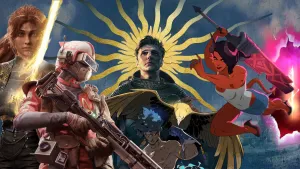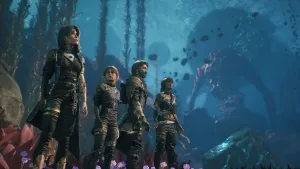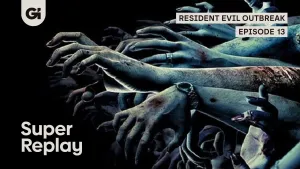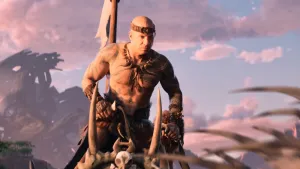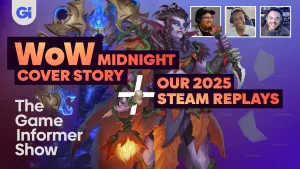Our extra-large special edition is here. Subscribe today and receive the 25% longer issue at no extra cost!
Top Of The Table – Teenage Mutant Ninja Turtles: Shadows Of The Past

If you’ve grown up in any time since the early 1980s, you’ve likely had one or another version of the Teenage Mutant Ninja Turtles embedded in your childhood consciousness. These four green sewer-dwelling heroes have fought it out with the baddies in cartoons, movies, toys, video games, and comics, and many of those adventures have been great and action-packed. But this is the first time I can recall being excited about a tabletop iteration of the universe. TMNT: Shadows of the Past is a stellar interpretation of the long-running license, offering opportunities for cooperation, pitched combat, slick movement options, and lots of fun characterization, and it scratches any itch you might have to reenter the world of these teenage heroes, no matter which version you recall best.
Designed by Kevin Wilson and published by IDW Games, Shadows of the Past is set in one of the most recent incarnations of the fiction, IDW’s own comic book take of the Turtles. The long-running ongoing comic from IDW has been a blast for several years now, offering some entertaining new twists on old situations, but almost always maintaining the familiar vibe of major conflicts and characters. The Shadows of the Past game looks directly to that comic for both art and story. The great box and card art has a colorful and dynamic style; characters usually appear in poses of action and motion that reflect the nearly constant battle scenes that the game presents. Meanwhile, the entire game unfolds as part of a series of ongoing interactive adventure comics, echoing moments from the IDW comics. Each brief session is a single conflict drawn from the comic adventures, and depending on who wins or loses, you can maintain a full campaign storyline from beginning to end.
Structurally, the game slots easily into the one-versus-many style. Up to four players take on the roles of Leonardo, Raphael, Donatello, and Michelangelo, while another player always adopts the role of the villain. Each scenario is short and tightly scripted, with a focus on nearly constant action and battles. Early scenarios unfold quickly in about an hour – later battles tend to run a bit longer.
Each fight plays out on a modular board made up of tiles unique to the scenario. While these tiles are only flat cardboard, each grid square has unique properties that help action and movement feel varied, and lend an imaginary verticality and shape. Leap from a rooftop into a pile of trash to cushion your fall. Grind along a rail to reach a distant location in a single move. Duck behind a barricade to dodge a flurry of shurikens. Color coding on each square offers clear messaging about where you are, and what you can do with your movement.

Shadows of the Past is filled with colorful components that evoke the Turtles mythology
For the hero players, the game’s most innovative feature comes through a clever dice activation system, in which you mix the innate abilities of your specific Turtle with a selection of character-specific dice rolled at the start of the turn. In keeping with the themes of brotherhood and teamwork that pervade the TMNT mythology, some of the dice you roll can be shared with your brothers, boosting their abilities in critical moments. Donnie might be in danger of taking a hit, but he can borrow a defensive die result from Leo to save the day. Maybe Mikey wants to ride his skateboard that extra square over, but he needs Raph’s help to do it. Raphael, in keeping with his lone wolf character, is happy to help out, but he won’t take aid from his brothers – instead, he gets more initial dice to fuel his actions. Taken together, this dice dynamic encourages constant communication and short-term forward thinking on the part of the cooperating players; it’s one of the big reasons that the game is so much fun.
While the villain player doesn’t get any of that fun cooperation, he has a deck of combat cards that fuel everything he does, leading to a lot of exciting scheming. Different cards allow for dramatic and unexpected moves through the battle, lending minions a semblance of a chance against the powerful Turtles, and giving big bads like Shredder devastating tools. Choice of cards is increasingly strategic as a battle unfolds, as many cards have effects that persist after play, and remain in effect for a couple of rounds before disappearing, so it’s possible to significantly increase the power of your whole team of bad guys through smart choices of when to play each card.
No matter which side you’re on, clear rules govern turn order and conflict resolution. The chance element inherent to the many dice rolls moves the game away from a classical strategy experience, but there are still ways to shape the outcome of events. That is especially thanks to a character’s focus, a stat that allows rerolls in opportune moments, and upping the tension as you decide whether to expend the precious resource. While turns move in a sensible way, the game sometimes struggles with its own complement of players. Begin with only two players, and one player must control all four of the Turtles, which simply doesn’t provide the same fun. But with a full five person game, downtime between turns becomes an issue, as you can sometimes have a long stretch between your character’s activation and your next chance to beat up the Foot Clan.
In addition to great artwork and narrative setup for each battle, IDW has done a great job of offering components that accentuate the action. Detailed unpainted minis dictate the tactical situation as play commences. Dice feature familiar icons from the fiction, like turtle shells for defense, or chi symbols to represent moments of healing and focus. Health is represented by pizza pies and slices that slowly get eaten away. The whole affair is awash in Ninja Turtle themes and nods.

Minis come unpainted, but talented painters can make the figures look like this
Shadows of the Past can be a lot of fun for a single evening of TMNT nostalgia and a couple of pitched tabletop skirmishes. Alternately, its available narrative adventure comics do a lot to extend the life of the game. Even if you don’t take advantage of the interactive win/loss conditions from one session to the next, the different available battles add variety and replayability.
This Teenage Mutant Ninja Turtles game’s reach doesn’t exceed its grasp. The battle system is robust without overt complexity, the strategic choices are more about immediate benefit than long-term thinking ahead. And a given session is quick and action-packed. While the available campaign structure is a welcome way to broaden the experience, Shadows of the Past focuses on what the franchise has always done right – exciting ninja battles – and rarely tries to stretch into greater complications. That’s just as it should be. Anyone who is (or was) a fan of these strange heroes will see just how well the game captures the spirit of the universe.
Despite my enjoyment of Shadows of the Past, there’s little doubt in my mind that the game wouldn't hold the interest of anyone but players who know the Turtles mythology, at least a bit. If you’re in that camp that never understood what all the fuss was about, I’d recommend checking out the Top of the Table hub by clicking on the banner below. I have new games to recommend every two weeks, and you’re bound to find something to entertain your gaming group. In the meantime, if you’d like to chat about the tabletop hobby, or you’d like some personalized recommendations, don’t hesitate to drop me a line via email or Twitter.


Get the Game Informer Print Edition!
Explore your favorite games in premium print format, delivered to your door.
- 10 issues per year
- Only $4.80 per issue
- Full digital magazine archive access
- Since 1991

